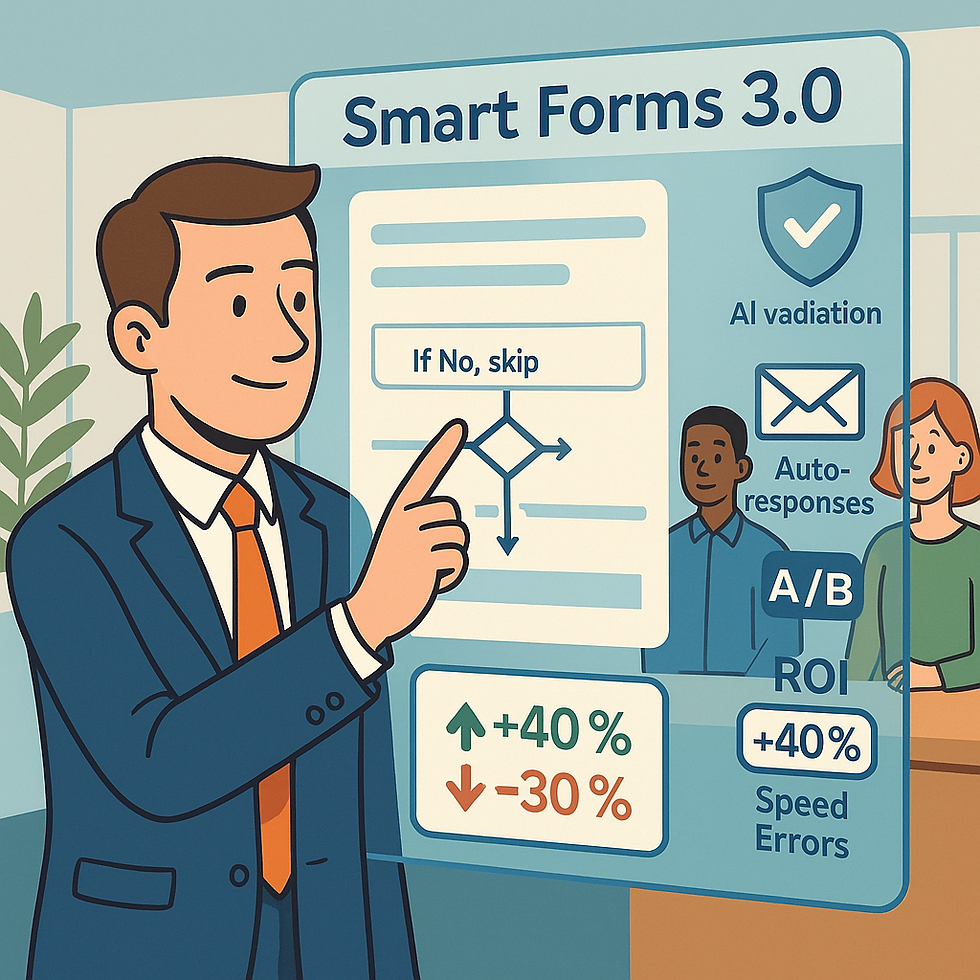Smart Forms 3.0: Enhance Data Integrity With Contextual Logic
- dlane40
- Aug 5
- 3 min read
Introduction to Smart Forms 3.0
Smart Forms 3.0 represents a significant leap forward in data collection and management. By incorporating contextual logic, these forms ensure that data is captured accurately and efficiently. Conditional routing steers users through the form, branded auto-responses personalize interactions, and AI-powered validation guarantees data integrity. These advancements offer numerous benefits for businesses seeking to streamline operations.

Enhancing Data Accuracy Through AI and Conditional Logic
The backbone of Smart Forms 3.0 is its ability to implement contextual logic, which guides users through relevant fields based on their inputs. For example, a healthcare form might skip certain sections if the user indicates that they dont have a previous medical condition. This not only saves time but also minimizes errors by ensuring that relevant information is always requested and irrelevant questions are skipped. Studies show that forms with contextual logic experience reduction in user errors. smarthealthhit.org
Evaluating Tools for Building Contextual Forms: A Comprehensive Guide
Essential Tools for achieving contextual logic include form builders like Wufoo, Typeform, and Jotform. Each platform offers unique features that support tasks such as conditional routing and AI-powered validation. For instance, Wufoo provides robust conditional logic where users can adjust form paths based on answers, ensuring forms adapt dynamically. Typeform excels in creating beautiful, interactive forms with built-in AI-driven text validation. Jotform stands out for its extensive integration options and customization, making it versatile for various business needs. Key factors to consider when evaluating these tools include ease of use, integration capabilities, and the level of customization offered.
Best Practices for Implementing Contextual Logic in Forms
Implementing contextual logic effectively involves several best practices. First, design forms with user experience in mind. Ensure that conditions flow logically and questions align with user needs. For example, in a job application form, conditional branching can streamline the application process by only asking necessary questions based on previous answers. Regularly test forms to iron out inconsistencies or bugs that might compromise the user experience. Another critical best practice is to consistently update and maintain your forms to adapt to changing business needs. Incorporating feedback from users and stakeholders can enhance form efficiency and relevance over time. Businesses can implement A/B testing to decide which form flow delivers better results.
Cost-Effectiveness and ROI of Contextual Logic Systems
Evaluating the cost-effectiveness and return on investment (ROI) of implementing Smart Forms 3.0 is crucial for businesses. Initial development costs can be offset by the long-term benefits such as reduced data entry errors, improved data quality, and increased user satisfaction. Furthermore, businesses with optimally designed forms can see a significant boost in user engagement and conversion rates, as users appreciate the streamlined processes. It is essential to measure the ROI by tracking metrics such as form completion rates, data accuracy, and user satisfaction surveys.
Conclusion
In conclusion, Smart Forms 3.0 revolutionizes how data is collected and validated, offering businesses efficient and user-friendly tools. By leveraging contextual logic, conditional routing, AI-powered validation, and auto-responses, companies can capture cleaner, more accurate data. Integrating these advancements into form design not only simplifies user experiences but also enhances overall workflows. To ensure optimal results, businesses should continually evaluate and fine-tune their forms, aligning with the evolving needs of both users and the market. Investing in these smart forms is not just about efficiency; its about building user trust, improving operational fidelity, and creating a winning edge in data acquisition.





Comments